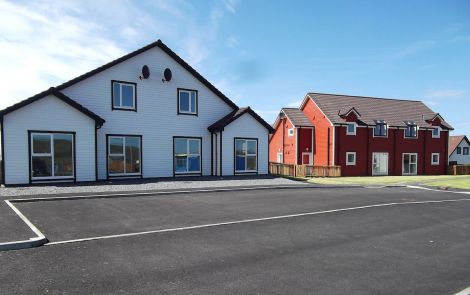News / National schemes don’t address isles’ fuel poverty
A COMMISSION aimed at tackling inequality heard on Monday that more than half of Shetland households feel their insulation is not up to scratch – hampering attempts to reduce the alarming number of islanders living in fuel poverty.
An in-depth study in 2013 by the Citizens Advice Bureau (CAB) first laid bare the extent of the problem, deeming 43 per cent of isles households to be fuel poor, and there is little sign of things improving after a lengthy spell of rising fuel prices and declining pay packets.
At a media briefing in Islesburgh on Tuesday morning, commission chairman Alastair Hamilton said it was clear that government-run schemes did not recognise the realities of Shetland’s climate.
Often programmes are designed to cope with extreme lows in temperature – whereas the islands are subjected to consistently cold weather over prolonged periods. “Although we don’t have extreme temperatures, we do have quite low temperatures for a considerable period of time,” he said.
Likewise, the UK’s benefits system is not designed to fit the circumstances of communities like Shetland, where the cost of living is estimated to be 40 per cent greater than on the mainland.
SIC infrastructure director Maggie Sandison, who gave evidence on Monday, said the UK and Scottish governments were being lobbied to ensure energy efficiency schemes can be tailored to meet small rural communities’ needs.
Of the 4,644 homes surveyed by CAB in 2013, some 52 per cent of respondents felt their homes needed better insulation. More than half had cut back on essentials to pay for fuel, while 46 per cent were leaving rooms unheated due to the cost.
Energy firms are obliged to spend money on improving efficiency, but tend to focus on larger scale identikit housing estates on the mainland.
In Shetland, “we find every single house needs a unique solution”, Sandison said. Generally it will cost around £20,000 to properly insulate a Shetland home – but the maximum grant is around £7,500.
Become a member of Shetland News
She said the rocketing cost of energy – up 37 per cent between 2010 and 2013 – had dragged many more households into fuel poverty.
Hamilton said he was surprised to learn that, despite lots of new properties being built, 10 per cent fewer households in Shetland had central heating compared to nationwide figures.
Cars are ‘necessity, not luxury’ in rural areas
The commission also took evidence relating to transport on Monday. In terms of ferry and air links to the Scottish mainland, Hamilton said that would mostly comprise lobbying “to see if we can get better-designed subsidy packages for Shetland’s services”.
Travel in and out of Shetland was found to be significantly higher than even other island groups face. For instance, the cheapest return fare to Edinburgh for a family of four was £552 (with air discount) from Sumburgh but only £360 from Stornoway.
Governments are entitled to subsidise air and ferry fares to a greater extent than they currently do. EU rules allow for a discount of up to 80 per cent – compared to the 40 per cent on offer to islanders under the Air Discount Scheme (ADS).
Internal transport was an area where local policy makers could help lessen inequality in the way concessionary fares are managed, Hamilton said.
That could mean concessions for those claiming certain types of working-age benefits, for example.
One of Shetland’s youth parliament members, Kelvin Anderson, outlined how school pupils under the age of 16 benefited from half-price fares – but often end up paying higher fares between the age of 16 and 18, when many are still attending school.
Young Scot cards entitle those aged 11-25 to a third off bus fares, but Anderson said it was poorly advertised: “The only reason I know about it is because my mum is a bus driver,” he said.
There are also timetabling issues, for instance, with some Shetland College students finishing class at 3.30pm but having to wait until 5pm for a bus back into Lerwick from Gremista.
Anderson also highlighted how car insurance is much more costly for young drivers who – unlike their city counterparts – don’t have ready access to cheap bus fares.
CAB’s Lerwick branch manager Karen Eunson said that, paradoxically, taxis in Shetland were frequently used by some of the poorest folk in society – those unable to afford their own vehicle in a car-dependent community where public transport options are limited.
Sandison said the UK benefits system was predicated on the assumption that people had ready access to “very cheap” bus fares.
But in remote, rural parts of Shetland a car – sometimes even two per family – “isn’t a luxury, it’s a necessity”.
Commission member Catriona Waddington felt other avenues, such as car sharing, could be explored further.
“It’s important to make public transport as good as we can but recognise there are other things we can do as well,” she said.
Shetland’s Commission on Tackling Inequalities holds its next meeting on 28 October, when the focus will be on geography and communities. After a further session in November on education and skills, in December the commission will begin putting its findings together.
Those taking part said it was proving a “really useful” exercise in allowing evidence of inequality to be presented to influential folk within public life in the islands.
Become a member of Shetland News
Shetland News is asking its many readers to consider paying for membership to get additional features and services: -
- Remove non-local ads;
- Bookmark posts to read later;
- Exclusive curated weekly newsletter;
- Hide membership messages;
- Comments open for discussion.
If you appreciate what we do and feel strongly about impartial local journalism, then please become a member of Shetland News by either making a single payment, or setting up a monthly, quarterly or yearly subscription.





























































